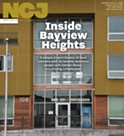Thursday, April 7, 2022
Coastal Commission Votes to Move Forward with Humboldt Offshore Wind Exploration
Posted By Thadeus Greenson @ThadeusGreenson on Thu, Apr 7, 2022 at 3:58 PM
The California Coastal Commission voted unanimously today to conditionally concur with a federal determination that allowing energy companies and organizations to study a proposed offshore wind farm area on the Humboldt County Coast is consistent with the California Coastal Management Program.
The highly technical and bureaucratic vote clears the way for companies interested in purchasing federal leases to erect large, floating offshore wind turbines to generate renewable electricity off the coast to begin studying and assessing the project site. Known as the Humboldt Wind Energy Area, that site spans 132,000 acres 21 miles off Humboldt Bay, in which the federal Bureau of Ocean Energy Management plans to sell up to three leases in an auction process slated to begin in the fall.
The commission’s vote today does not approve the wind farms or the start of any construction activities — all of which would come back before the commission in the future for further review — just the potential effects of lease exploration activities, like site characterization and assessment. Those activities will likely include additional boat trips out to the area — nearly 500 estimated over a three-year period — and the installation of up to three buoys outfitted with scientific sampling equipment.
But commission staff made clear in its report and presentation to the commission that while BOEM believes it is premature to analyze the full scope of environmental impacts of turning a swath of ocean waters off Humboldt Bay into a wind farm, such a transformation is a “reasonably foreseeable” result of today’s vote, so should be considered to the extent possible. Further, commission staff explained this consistency determination was a chance to lay a foundation for the commission’s role in the process moving forward as the state and federal governments continue to push for a more sustainable energy grid.
To that end, staff recommended — and the commission approved — seven conditions aimed at mitigating environmental impacts of the site study work, keeping stakeholders involved in the discussion and gathering relevant data.
Specifically, the commission approved the following seven conditions:
Condition 1 requires BOEM to work with commission staff to ensure that lessees’ survey, sampling and analysis plans are coordinated to minimize impacts to coastal resources.
Condition 2 requires lessees to avoid “intentional contact” with hard substrate, rock outcroppings, seamounts of deep-sea coral/sponge habitats, all of which are critical for the region's biodiversity.
Condition 3 requires vessels conducting site research not exceed a speed of 10 knots to avoid unintentional strikes of sea mammals.
Condition 4 requires BOEM to ensure commercial fishing vessels safe navigation through the lease areas.
Conditions 5 and 6 require engagement with environmental justice communities and Native communities on site assessment and construction and operations plans.
Condition 7 requires lessees to have an independent fisheries liaison to work with the commercial fishing community to make sure site assessment activities don’t conflict with local fisheries.
The overwhelming sentiment of the commissioners was that staff had done an excellent job of working with stakeholders and across state and federal agencies to produce a report and recommendations that both properly assessed impacts of the site exploration activities and also set the table for future conversations, all while working under very tight timelines.
“California is not only a leader in clean energy in the world, we are a leader in our coastal, wildlife and marine protection, particularly for biodiversity,” Commission Chair Donne Brownsey said. “I think that this is a good start in show that those two really important goals can be balanced and really work together. I do think that’s where we’re starting and I hope that’s where can end.”
During her staff report on the subject, Commission Deputy Director of Energy, Ocean resources and Federal Consistency Kate Huckelbridge noted there are a lot of unknowns with deep-water, floating offshore wind farms but made clear there will be environmental impacts.
“There’s no free lunch,” she said, explaining there will be “tradeoffs” as the state works to triple its clean energy production in the coming decades to achieve the goal of carbon neutrality by 2045.
Moving forward in the process, Huckelbridge said data collection and “adaptive management” will be crucial components, saying plainly the full-scale impacts of an offshore wind farm on the Pacific Coast won’t be clear until “projects are in the water and we are able to monitor and measure the effects.”
In his comments at the meeting, Humboldt County Third District Supervisor and Commissioner Mike Wilson underscored that this project could have profound impacts on Humboldt County.
"We have a community leaning into this — we feel a community and a global responsibility to be a part of this effort to address climate change," Wilson said, quickly adding that the community's feet are also "firmly planted" in working to minimize potential negative impacts. "No one is going to roll over us on this. We are taking this really serious."
Check out commission staff’s full staff report and supporting documents here and check next week’s Journal for a more thorough report on today’s meeting.
The highly technical and bureaucratic vote clears the way for companies interested in purchasing federal leases to erect large, floating offshore wind turbines to generate renewable electricity off the coast to begin studying and assessing the project site. Known as the Humboldt Wind Energy Area, that site spans 132,000 acres 21 miles off Humboldt Bay, in which the federal Bureau of Ocean Energy Management plans to sell up to three leases in an auction process slated to begin in the fall.
The commission’s vote today does not approve the wind farms or the start of any construction activities — all of which would come back before the commission in the future for further review — just the potential effects of lease exploration activities, like site characterization and assessment. Those activities will likely include additional boat trips out to the area — nearly 500 estimated over a three-year period — and the installation of up to three buoys outfitted with scientific sampling equipment.
But commission staff made clear in its report and presentation to the commission that while BOEM believes it is premature to analyze the full scope of environmental impacts of turning a swath of ocean waters off Humboldt Bay into a wind farm, such a transformation is a “reasonably foreseeable” result of today’s vote, so should be considered to the extent possible. Further, commission staff explained this consistency determination was a chance to lay a foundation for the commission’s role in the process moving forward as the state and federal governments continue to push for a more sustainable energy grid.
To that end, staff recommended — and the commission approved — seven conditions aimed at mitigating environmental impacts of the site study work, keeping stakeholders involved in the discussion and gathering relevant data.
Specifically, the commission approved the following seven conditions:
Condition 1 requires BOEM to work with commission staff to ensure that lessees’ survey, sampling and analysis plans are coordinated to minimize impacts to coastal resources.
Condition 2 requires lessees to avoid “intentional contact” with hard substrate, rock outcroppings, seamounts of deep-sea coral/sponge habitats, all of which are critical for the region's biodiversity.
Condition 3 requires vessels conducting site research not exceed a speed of 10 knots to avoid unintentional strikes of sea mammals.
Condition 4 requires BOEM to ensure commercial fishing vessels safe navigation through the lease areas.
Conditions 5 and 6 require engagement with environmental justice communities and Native communities on site assessment and construction and operations plans.
Condition 7 requires lessees to have an independent fisheries liaison to work with the commercial fishing community to make sure site assessment activities don’t conflict with local fisheries.
The overwhelming sentiment of the commissioners was that staff had done an excellent job of working with stakeholders and across state and federal agencies to produce a report and recommendations that both properly assessed impacts of the site exploration activities and also set the table for future conversations, all while working under very tight timelines.
“California is not only a leader in clean energy in the world, we are a leader in our coastal, wildlife and marine protection, particularly for biodiversity,” Commission Chair Donne Brownsey said. “I think that this is a good start in show that those two really important goals can be balanced and really work together. I do think that’s where we’re starting and I hope that’s where can end.”
During her staff report on the subject, Commission Deputy Director of Energy, Ocean resources and Federal Consistency Kate Huckelbridge noted there are a lot of unknowns with deep-water, floating offshore wind farms but made clear there will be environmental impacts.
“There’s no free lunch,” she said, explaining there will be “tradeoffs” as the state works to triple its clean energy production in the coming decades to achieve the goal of carbon neutrality by 2045.
Moving forward in the process, Huckelbridge said data collection and “adaptive management” will be crucial components, saying plainly the full-scale impacts of an offshore wind farm on the Pacific Coast won’t be clear until “projects are in the water and we are able to monitor and measure the effects.”
In his comments at the meeting, Humboldt County Third District Supervisor and Commissioner Mike Wilson underscored that this project could have profound impacts on Humboldt County.
"We have a community leaning into this — we feel a community and a global responsibility to be a part of this effort to address climate change," Wilson said, quickly adding that the community's feet are also "firmly planted" in working to minimize potential negative impacts. "No one is going to roll over us on this. We are taking this really serious."
Check out commission staff’s full staff report and supporting documents here and check next week’s Journal for a more thorough report on today’s meeting.
Speaking of...
Readers also liked…
more from the author
-
Cal Poly Humboldt Closed as Protesters Occupy Building
- Apr 23, 2024
-
Seeking Salvation
'Living in amends,' a candidate for resentencing hopes for another chance
- Apr 18, 2024
-
UPDATE: Artillery Shell Deemed Safe in Ferndale
- Apr 12, 2024
- More »





































